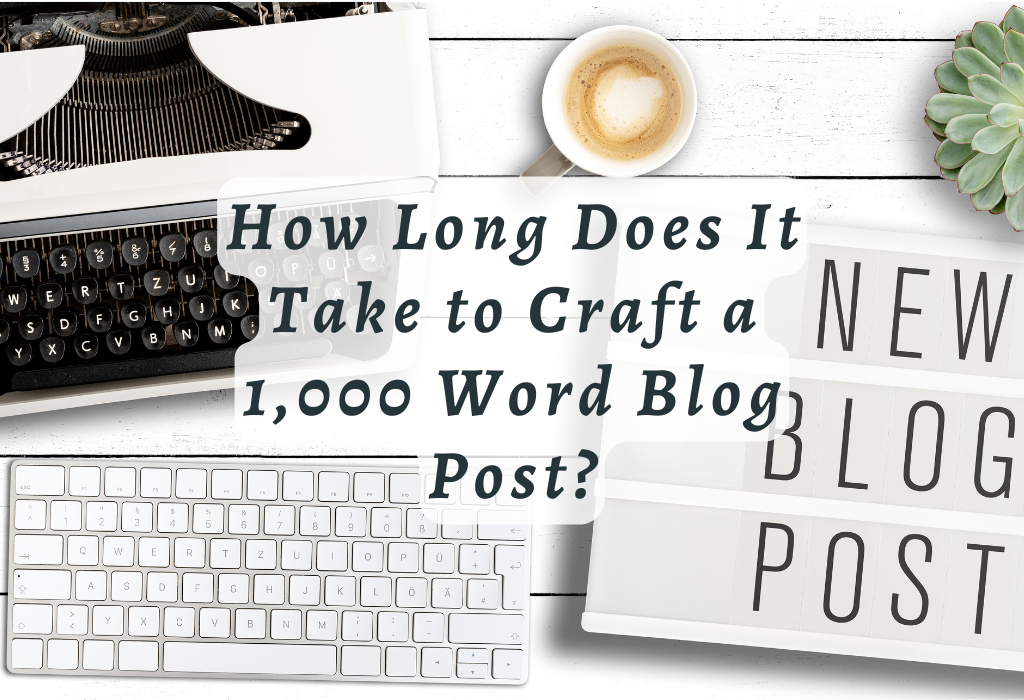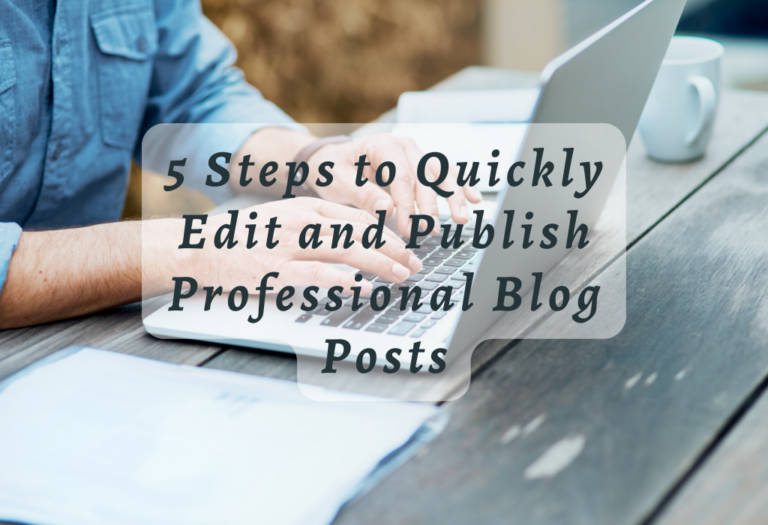How Long Does It Take to Craft a 1,000 Word Blog Post?
Writing a 1,000 word blog post is no small feat. It requires research, structure and discipline to get it done efficiently. So how long does it take to write such an article? The answer depends on many factors including the type of article you are writing and your experience as a writer.
To assist you and every other blogger online, we have compiled a comprehensive guide that details the many stages of a blog writing process with an emphasis on how much time each stage will take. Find out how much time you need to dedicate to writing one good piece of content and what the research says by reading on.

Factors that Affect Writing Speed
The amount of time it takes to write a 1,000 word blog post is affected by several factors. These include the complexity of the topic being discussed, how familiar the writer is with the subject matter, and how quickly they are able to type or write out their thoughts. Additionally, writers who have more experience in creating content may be able to work faster than those who are just starting out.
Estimating Time for Writing a 1,000 Word Blog Post
Estimating how long it will take you to complete your 1,000 word blog post requires taking into account all of these variables. Generally speaking though, experienced writers should plan on spending at least two hours completing this task while newbies should expect closer to four hours or more depending on their skill level and comfort with writing content.
Tips for Becoming a Faster Writer
If you want to become faster at writing your blog posts there are some tips that can help you achieve this goal.
Firstly, make sure that you do thorough research before beginning so that you don’t waste time looking up facts as you go along; having all relevant information already gathered will help save valuable minutes when crafting your article.
Secondly, try using voice-to-text software if available; this can greatly reduce typing times allowing for quicker completion of articles overall.
Finally, practice makes perfect; dedicate yourself to improving your craft through regular practice sessions and soon enough even complex topics won’t seem like such an intimidating challenge.
My Blog Post Writing Process for High-Volume Output
Brainstorming and Researching Ideas
Before I begin writing a blog post, I always start by brainstorming ideas. This involves researching topics related to my niche, reading other articles in the same field, and coming up with original content ideas that will be interesting for my readers.
Outlining the Content Structure
Once I have some ideas in mind, I create an outline of what my blog post should look like. This includes breaking down each section into subsections and deciding which points need to be included in each one.
Writing the First Draft
After creating an outline, it’s time to write the first draft of my blog post. To make sure that all relevant information is included, I often refer back to my outline while writing this initial version of the article.
Editing and Revising the Content
The last step before publishing a blog post is editing and revising it for accuracy and clarity. During this process, I check for any typos or grammar mistakes as well as making sure that all facts are correct and sources are properly cited if needed.
By following the process outlined in this article, you can quickly and efficiently create high-quality blog posts with a consistent output. Now let’s look at whether 1,000 words is long enough for a blog post or if you should consider longer content
Is 1,000 Words Long Enough for a Blog Post?
When it comes to blog posts, length is an important factor. Longer posts can provide more detailed information and allow for greater depth of discussion than shorter posts. On the other hand, shorter posts are often easier to read and digest quickly.
Benefits of Longer Posts vs. Shorter Posts:
Longer blog posts offer a number of advantages over their shorter counterparts. For one, they can be used to cover complex topics in detail or provide comprehensive overviews on multiple related topics. They also give readers more time to engage with the content and absorb its key points before moving onto another post or article.
As a result of their greater potential for organic traffic creation via SEO strategies like keyword optimization, longer blog posts also tend to rank higher in search engine results pages (SERPs). When writing blog posts, remember that lengthier pieces might help you establish your credibility as an expert in your field. Lengthier blog pieces do better in almost every statistic because they provide more value to readers and display your expertise.
When to Use Short Posts vs. Long Posts
Shorter blog posts should be used when you need to convey simple messages that don’t require much explanation or elaboration. They are also great for quickly updating people about new products or services your business offers without having to write lengthy descriptions every time. Additionally, short blog posts are ideal for social media platforms where users prefer concise pieces of content that get straight to the point without any unnecessary words getting in the way of understanding what is being said.
Ultimately, the length of a blog post should be determined by its purpose. While 1,000 words may be sufficient for some posts, longer content can often provide more comprehensive information and better engagement with readers. Let’s look at how to become a faster writer so you can produce high-quality blog posts quickly.
Is it Possible to Become a Fast Writer?
Strategies for Improving Your Writing Speed and Efficiency
By following the strategies and tips outlined in this article, you can become a faster writer. Now let’s look at how different types of articles impact writing speed.
Types of Articles That Impact Writing Speed
How-to guides and tutorials are the most time consuming type of article to write. They require a lot of research, step by step instructions, and often include images or videos to explain concepts. Writing these types of articles quickly requires an organized approach with clear objectives in mind before beginning. For example, when writing a how-to guide on setting up an email account, it’s important to have all the necessary information ready ahead of time so that you can easily follow each step without having to look for additional resources while writing.
Listicles
Lists are an excellent method of organizing data into a format that is both simple to understand and simple to distribute. Blog readers who are short on time can nevertheless acquire the information they need from a list-style article. Lists are more likely to go viral than other types of content, and they are excellent for increasing site visitors’ engagement.
Info graphics
Info graphics are great for increasing exposure and traffic to your site, but they aren’t the best tool for generating leads. They are enjoyable to read, enlightening, and simple to comprehend. In addition, info graphics offer a welcome diversion from the typical Write-up for a Weblog
Checklists
What makes a list for me is the satisfaction of crossing things off. Do you agree? Knowing you’ve finished something you set out to do is very rewarding. Assisting your audience in accomplishing a task is much easier when you provide them with a detailed checklist. In contrast to how-to pieces, checklists don’t give readers any leeway in terms of what they should do. With so much to cover in so little time, checklists and cheat sheets are invaluable tools to have at the ready.
Different types of articles require different amounts of research and writing time, so it’s important to be aware of the type you are creating when planning your blog post. Now let’s look at some strategies for growing your newer blog.
Suggestions for Growing Your Newer Blog:
Take the time to reply to the feedback
One of your top priorities should be attending to this. Be respectful to your audience. Never settle for merely saying “thank you.” Act with deliberation. Make an effort to start a discussion and maybe even a friendship. If the same name keeps popping up in the comments, you might want to check out their blog and leave a comment there. Create a friendly atmosphere in the comments, and people will keep coming back to say hi. And interaction with your readers is the only way to grow that community.
Make sure you schedule your social media updates in advance
Someone once asked me whether I ever go to bed because I seem to be constantly promoting my company on various social media platforms. In a word, yes. What’s my ace in the hole? Part of my social media output is preplanned. Buffer, Hootsuite, Planoly, and CoSchedule are just a few of the many free and paid tools available to assist you in this endeavour. As a result, I can update my social media accounts while I’m at work or in bed.
Despite the common saying, appearance is still important
Blog layout and Instagram photos matter. This is analogous to a book jacket. Even if the content is fantastic, you may lose some readers if the presentation is dull, too similar to a template, or too chaotic. A blog designer can make something unique for you, or you can buy a premium theme to make your site stand out.
Content Marketing Strategies to Increase Traffic
Social Media
Social media platforms are great tools for increasing visibility and engagement with potential readers. It is important to be active on multiple channels such as Facebook, Twitter, Instagram or LinkedIn depending on who your target audience is. You can also use social media advertising campaigns if you have a budget available for this purpose; however, organic reach can often be just as effective if done correctly. Posting regularly with engaging visuals and captivating copy can help drive more people back to your blog over time while building relationships with potential customers in the process.
Work on your SEO
Almost half of my site’s guests discovered it through a search engine. In other words, you’re losing out on a tone of prospective readers if you don’t SEO the living daylights out of your pieces.
By implementing the above strategies, you can begin to grow your blog and increase traffic. Now let’s look at some content marketing strategies that will help you maximize those efforts.
Creating Engaging Content That Resonates With Your Audience
To increase traffic levels, content must be engaging and resonate with your target audience. This means creating content that is relevant to their interests, needs, and challenges. It should also be informative and entertaining in order to capture the attention of readers. Additionally, it’s important to ensure that the content is well-written with no spelling or grammar errors as this can have a negative impact on reader engagement.
Tracking
Tracking results through analytics tools such as Google Analytics will help you measure the success of your efforts over time so that you can make adjustments accordingly if needed. By measuring metrics such as page views per visit rate or average session duration, you will gain valuable insights into how effective your strategies are at increasing traffic levels; this in turn allows for further refinement and improved results in the future.
FAQs in Relation to How Long Does it Take to Write a 1,000 Word Blog Post?
Conclusion
Time and effort are required to ensure that the material is well-written and applicable to the situation. It could take as little as an hour or as long as several days to write an article. When you write more, your writing speed will improve. Before committing your ideas to paper, spend some time planning them first, and break up large undertakings into manageable portions. Your blog entries will acquire a greater number of views and visibility on the web if you make use of content marketing tactics such as search engine optimization. If you keep these criteria in mind, you should be able to effortlessly and rapidly generate material that keeps the attention of the readers.
Are you curious about search engine optimization and content promotion and want to learn more about them? A blog post that is one thousand words long could take some time to compose. Blog entries that perform well in search engines can be written in a flash with the assistance of the website curationsoft. Our user-friendly software will help you save time without compromising the quality of the material you produce, which has been shown to boost the number of website visitors and the number of leads generated. Try out our service now without taking any risks in order to improve the workflow of the material you produce.





